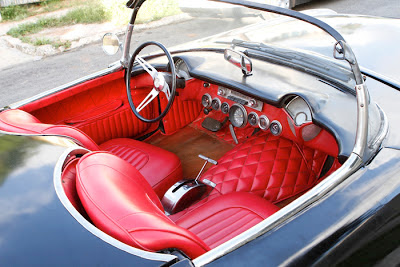 |
| Interior isn't all stock, but retains flavour of a '50s sports car. |
More of the story of Esterio Segura's 1954 Chevrolet Corvette has emerged. The car's previous owner, we learn from the Spanish language magazine Excelencias Del Motor, was Andreas Winkler, a Swiss national who lives in Havana.
Winkler owned the Corvette – serial No. E54S001747 – from about 2000 until a year ago. He bought it after a chance sighting. He and a visiting Swiss friend were on the Malecón, Havana's famous seawall boulevard, when the black two-seater drove by. His companion recognized the American-made sports car as rare and potentially valuable. At the friend's urging, they followed the Corvette to the home of its owner, who, it turned out, was planning to leave Cuba and yes, was willing to sell.
Of the car's history, the owner could supply just one interesting item. Early in its life, it was said to have been raced in Europe. (Whether it was Cuban-owned at the time is unknown, but given Cuba's active car racing scene in the 1950s, it's certainly possible.) After crashing at a track in the Netherlands, the Corvette was sent – or sent back – to Cuba, where new metal parts were substituted for its damaged fibreglass front end.
There are interesting similarities here to the story of Portuguese rally driver Horácio Macedo's 1955 Corvette, right to the replacement metal front clip, but then, race cars do tend to crash.
 |
| Current owner Esterio Segura takes a guest for a ride. |
Plus, at 191 centimetres (six-foot-three), Winkler had trouble squeezing in when the top was up.
"The best hint I can give you is that John Wayne owned a '54 Corvette and changed/resold it after 30 days because the car is too small for big guys."
Winkler believes the Corvette's gasoline engine is the original Blue Flame six, or at least a correct General Motors six-cylinder of the type that still powers many Chevies in Cuba. And while Rob Simons' photos of the car show a chrome shift console that obviously was a later addition (the original shifter protruded from the side of the transmission tunnel), Winkler remembers that the automatic gearbox itself had two speeds, indicating it could be the original Powerglide.
The photos show other substitutions – a different steering wheel and radio, updated gauges, quilted upholstery in place of carpeting. The car wouldn't be up to a purist's standards, but still, this survivor is certainly Cuba-correct.
Andreas Winkler remains an admirer, even after trading it to his friend Esterio Segura. The payment in return? A bronze sculpture by the artist. Or, in Winkler's words, "another fantastic piece of art," and fair value for the fiberglass-and-metal sculpture he drove for a decade.
 |
| Havana Corvette is said to have been raced, and crashed, in Europe. |
Photos by Rob Simons, who travelled to Cuba with the Entrepreneurs' Organization. Used by permission.
